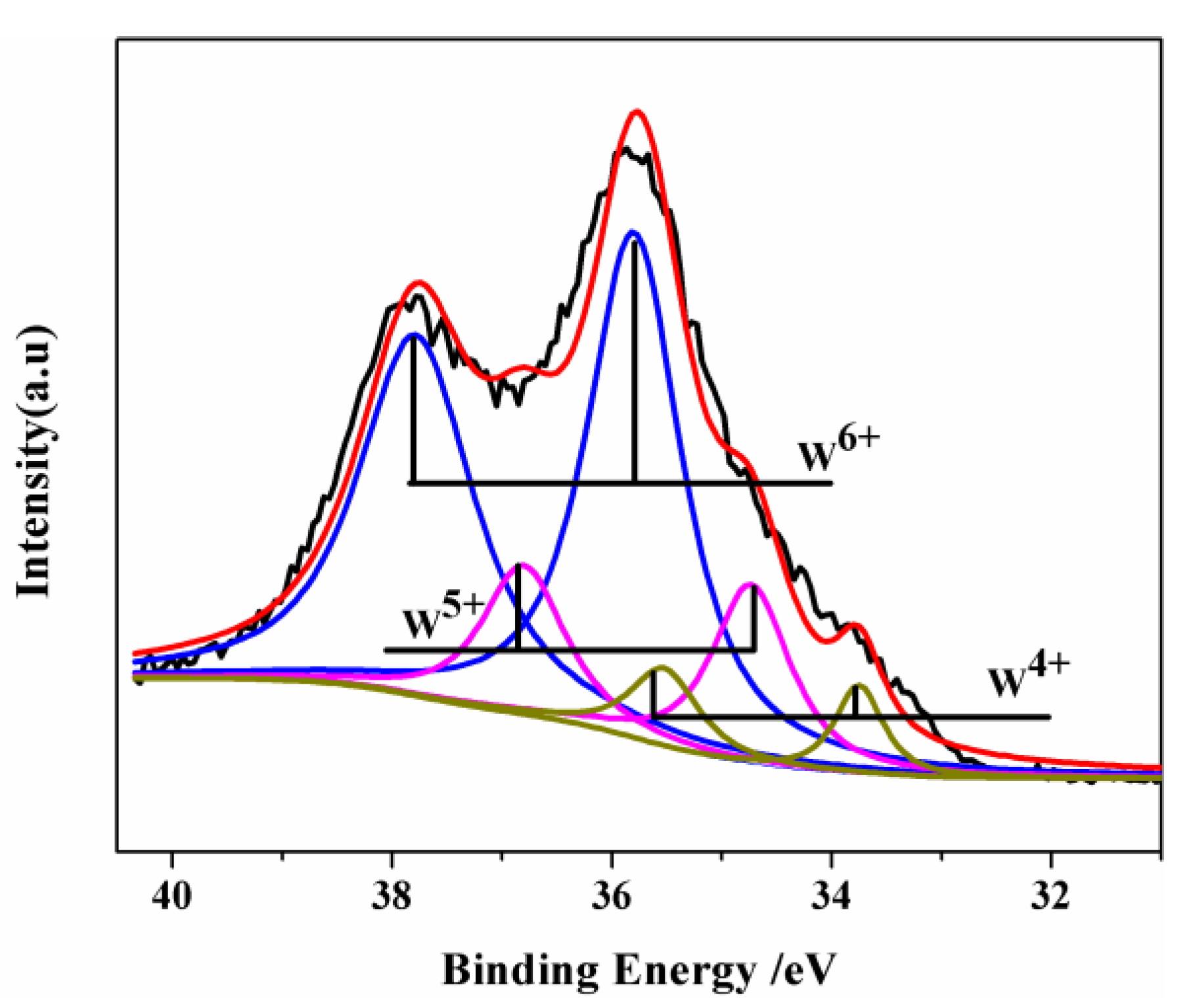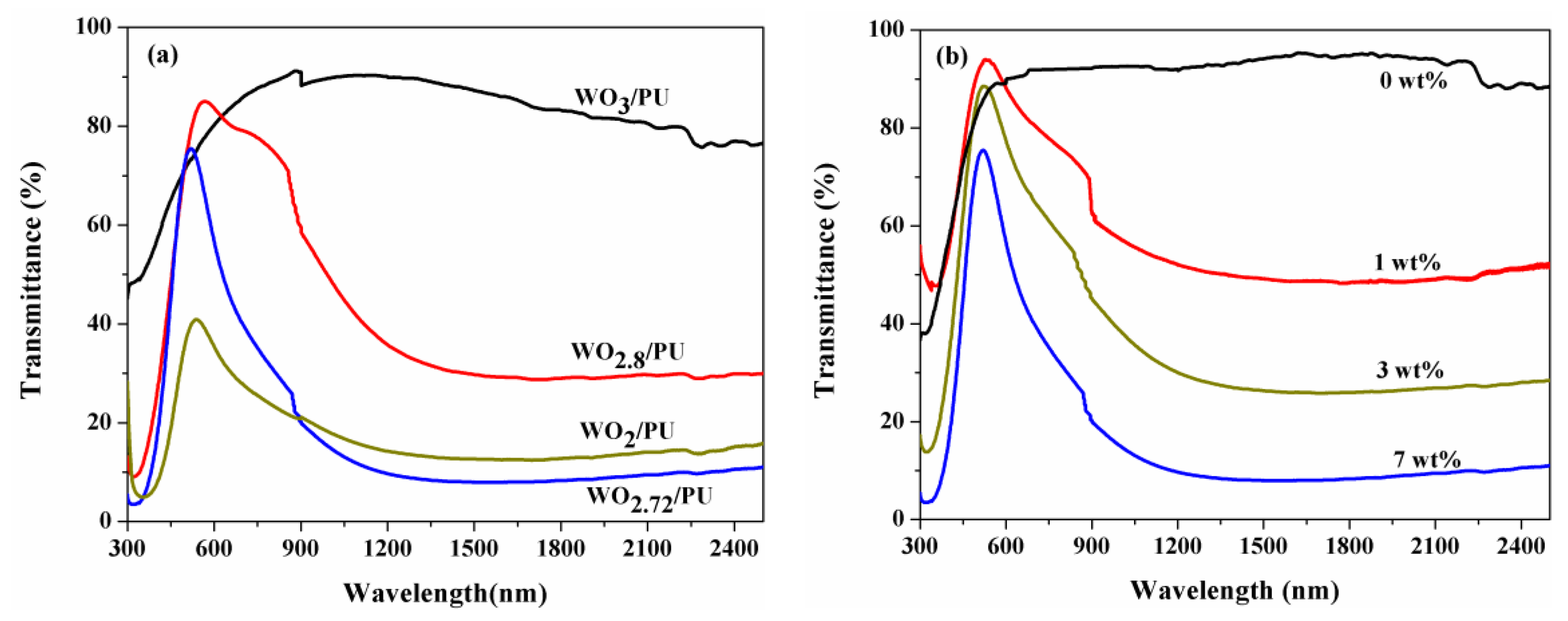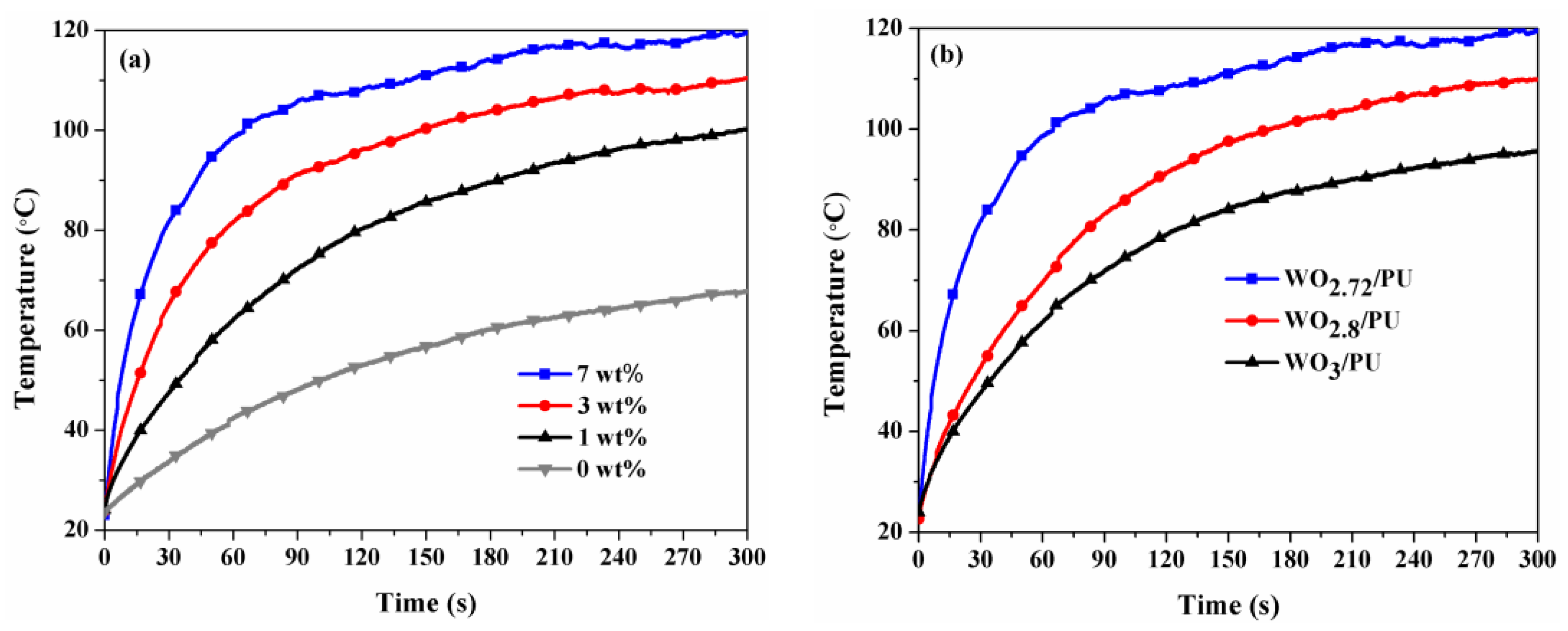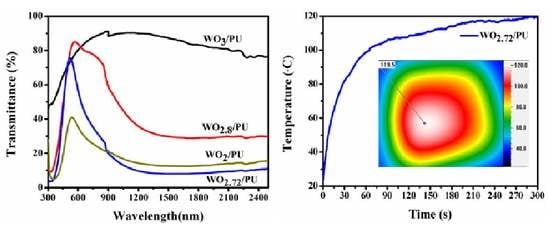Highly Efficient Near Infrared Photothermal Conversion Properties of Reduced Tungsten Oxide/Polyurethane Nanocomposites
Abstract
:1. Introduction
2. Results and Discussion
2.1. Characterization of WO3-x Nanoparticles
2.2. Optical Properties and Morphologies of WO3-x/PU Nanocomposites
2.3. NIR Photothermal Conversion and Thermal Properties of Nanocomposites
3. Materials and Methods
3.1. Materials
3.2. Preparation of WO3-x Nanoparticles
3.3. Preparation of WO3-x/PU Nanocomposites
3.4. Characterization
4. Conclusions
Acknowledgments
Author Contributions
Conflicts of Interest
References
- Choi, J.; Moon, K.; Kang, I.; Kim, S.; Yoo, P.J.; Oh, K.W.; Park, J. Preparation of quaternary tungsten bronze nanoparticles by a thermal decomposition of ammonium metatungstate with oleylamine. Chem. Eng. J. 2015, 281, 236–242. [Google Scholar] [CrossRef]
- Yan, M.; Gu, H.; Liu, Z.; Guo, C.; Liu, S. Effective near-infrared absorbent: Ammonium tungsten bronze nanocubes. RSC Adv. 2015, 5, 967–973. [Google Scholar] [CrossRef]
- Guo, C.; Yin, S.; Dong, Q.; Sato, T. Near-infrared absorption properties of RbxWO3 nanoparticles. CrystEngComm 2012, 14, 7727–7732. [Google Scholar] [CrossRef]
- Guo, C.; Yin, S.; Huang, L.; Yang, L.; Sato, T. Discovery of an excellent ir absorbent with a broad working waveband: CsxWO3 nanorods. Chem. Commun. 2011, 47, 8853–8855. [Google Scholar] [CrossRef] [PubMed]
- Uhuegbu, C.C. Photo-thermal solar energy conversion device. JETEAS 2011, 2, 96–101. [Google Scholar]
- Lizama-Tzec, F.; Macias, J.; Estrella-Gutiérrez, M.; Cahue-López, A.; Arés, O.; de Coss, R.; Alvarado-Gil, J.; Oskam, G. Electrodeposition and characterization of nanostructured black nickel selective absorber coatings for solar-thermal energy conversion. J. Mater. Sci. Mater. Electron. 2015, 26, 5553–5561. [Google Scholar] [CrossRef]
- Li, B.; Nie, S.; Hao, Y.; Liu, T.; Zhu, J.; Yan, S. Stearic-acid/carbon-nanotube composites with tailored shape-stabilized phase transitions and light-heat conversion for thermal energy storage. Energy Convers. Manag. 2015, 98, 314–321. [Google Scholar] [CrossRef]
- Hua, Z.; Li, B.; Li, L.; Yin, X.; Chen, K.; Wang, W. Designing a novel photothermal material of hierarchical microstructured copper phosphate for solar evaporation enhancement. J. Phys. Chem. C 2017, 121, 60–69. [Google Scholar] [CrossRef]
- Chen, C.-J.; Chen, D.-H. Preparation and near-infrared photothermal conversion property of cesium tungsten oxide nanoparticles. Nanoscale Res. Lett. 2013, 8, 57. [Google Scholar] [CrossRef] [PubMed]
- Chen, C.-J.; Chen, D.-H. Preparation of LaB6 nanoparticles as a novel and effective near-infrared photothermal conversion material. Chem. Eng. J. 2012, 180, 337–342. [Google Scholar] [CrossRef]
- Huang, X.; El-Sayed, M.A. Gold nanoparticles: Optical properties and implementations in cancer diagnosis and photothermal therapy. J. Adv. Res. 2010, 1, 13–28. [Google Scholar] [CrossRef]
- Yang, K.; Zhang, S.; Zhang, G.; Sun, X.; Lee, S.-T.; Liu, Z. Graphene in mice: Ultrahigh in vivo tumor uptake and efficient photothermal therapy. Nano Lett. 2010, 10, 3318–3323. [Google Scholar] [CrossRef] [PubMed]
- Yang, K.; Feng, L.; Shi, X.; Liu, Z. Nano-graphene in biomedicine: Theranostic applications. Chem. Soc. Rev. 2013, 42, 530–547. [Google Scholar] [CrossRef] [PubMed]
- Huang, X.; Tang, S.; Liu, B.; Ren, B.; Zheng, N. Enhancing the photothermal stability of plasmonic metal nanoplates by a core-shell architecture. Adv. Mater. 2011, 23, 3420–3425. [Google Scholar] [CrossRef] [PubMed]
- Horiguchi, Y.; Honda, K.; Kato, Y.; Nakashima, N.; Niidome, Y. Photothermal reshaping of gold nanorods depends on the passivating layers of the nanorod surfaces. Langmuir 2008, 24, 12026–12031. [Google Scholar] [CrossRef] [PubMed]
- Liu, Z.; Song, H.; Yu, L.; Yang, L. Fabrication and near-infrared photothermal conversion characteristics of au nanoshells. Appl. Phys. Lett. 2005, 86, 113109. [Google Scholar] [CrossRef]
- Ke, H.; Wang, J.; Dai, Z.; Jin, Y.; Qu, E.; Xing, Z.; Guo, C.; Yue, X.; Liu, J. Gold-nanoshelled microcapsules: A theranostic agent for ultrasound contrast imaging and photothermal therapy. Angew. Chem. 2011, 123, 3073–3077. [Google Scholar] [CrossRef]
- Chen, J.; Wang, D.; Xi, J.; Au, L.; Siekkinen, A.; Warsen, A.; Li, Z.-Y.; Zhang, H.; Xia, Y.; Li, X. Immuno gold nanocages with tailored optical properties for targeted photothermal destruction of cancer cells. Nano Lett. 2007, 7, 1318. [Google Scholar] [CrossRef] [PubMed]
- Li, G.; Zhang, S.; Guo, C.; Liu, S. Absorption and electrochromic modulation of near-infrared light: Realized by tungsten suboxide. Nanoscale 2016, 8, 9861–9868. [Google Scholar] [CrossRef] [PubMed]
- An, Y.; Li, X.-F.; Zhang, Y.-J.; Tao, F.-J.; Zuo, M.-C.; Dong, L.-H.; Yin, Y.-S. Fabrication and application of a new-type photothermal conversion nano composite coating. J. Nanosci. Nanotechnol. 2015, 15, 3151–3156. [Google Scholar] [CrossRef] [PubMed]
- Yang, C.; Chen, J.-F.; Zeng, X.; Cheng, D.; Cao, D. Design of the alkali-metal-doped WO3 as a near-infrared shielding material for smart window. Ind. Eng. Chem. Res. 2014, 53, 17981–17988. [Google Scholar] [CrossRef]
- Bai, H.; Su, N.; Li, W.; Zhang, X.; Yan, Y.; Li, P.; Ouyang, S.; Ye, J.; Xi, G. W18O49 nanowire networks for catalyzed dehydration of isopropyl alcohol to propylene under visible light. J. Mater. Chem. A 2013, 1, 6125. [Google Scholar] [CrossRef]
- Zhou, J.; Ding, Y.; Deng, S.Z.; Gong, L.; Xu, N.S.; Wang, Z.L. Three-dimensional tungsten oxide nanowire networks. Adv. Mater. 2005, 17, 2107–2110. [Google Scholar] [CrossRef]
- Wen, L.; Chen, L.; Zheng, S.; Zeng, J.; Duan, G.; Wang, Y.; Wang, G.; Chai, Z.; Li, Z.; Gao, M. Ultrasmall biocompatible WO3-x nanodots for multi-modality imaging and combined therapy of cancers. Adv. Mater. 2016, 28, 5072–5079. [Google Scholar] [CrossRef] [PubMed]
- Manthiram, K.; Alivisatos, A.P. Tunable localized surface plasmon resonances in tungsten oxide nanocrystals. J. Am. Chem. Soc. 2012, 134, 3995–3998. [Google Scholar] [CrossRef] [PubMed]
- Fang, Z.; Jiao, S.; Kang, Y.; Pang, G.; Feng, S. Photothermal conversion of W18O49 with a tunable oxidation state. Chem. Open 2017. [Google Scholar] [CrossRef]
- Lee, W.H.; Hwang, H.; Moon, K.; Shin, K.; Han, J.H.; Um, S.H.; Park, J.; Cho, J.H. Increased environmental stability of a tungsten bronze NIR-absorbing window. Fibers Polym. 2013, 14, 2077–2082. [Google Scholar] [CrossRef]
- Takeda, H.; Adachi, K. Near infrared absorption of tungsten oxide nanoparticle dispersions. J. Am. Ceram. Soc. 2007, 90, 4059–4061. [Google Scholar] [CrossRef]
- Wang, T.; Xiong, Y.; Li, R.; Cai, H. Dependence of infrared absorption properties on the Mo doping contents in MxWO3 with various alkali metals. New J. Chem. 2016, 40, 7476–7481. [Google Scholar] [CrossRef]
- Guo, C.; Yin, S.; Yan, M.; Kobayashi, M.; Kakihana, M.; Sato, T. Morphology-controlled synthesis of W18O49 nanostructures and their near-infrared absorption properties. Inorg. Chem. 2012, 51, 4763–4771. [Google Scholar] [CrossRef] [PubMed]
- Li, B.; Shao, X.; Liu, T.; Shao, L.; Zhang, B. Construction of metal/WO2.72/rGO ternary nanocomposites with optimized adsorption, photocatalytic and photoelectrochemical properties. Appl. Catal. B Environ. 2016, 198, 325–333. [Google Scholar] [CrossRef]
- Huo, D.; He, J.; Li, H.; Huang, A.J.; Zhao, H.Y.; Ding, Y.; Zhou, Z.Y.; Hu, Y. X-ray CT guided fault-free photothermal ablation of metastatic lymph nodes with ultrafine HER-2 targeting W18O49 nanoparticles. Biomaterials 2014, 35, 9155–9166. [Google Scholar] [CrossRef] [PubMed]
- Zhang, Y.; Li, B.; Cao, Y.; Qin, J.; Peng, Z.; Xiao, Z.; Huang, X.; Zou, R.; Hu, J. Na0.3WO3 nanorods: A multifunctional agent for in vivo dual-model imaging and photothermal therapy of cancer cells. Dalton Trans. 2015, 44, 2771–2779. [Google Scholar] [CrossRef] [PubMed]
- Chen, J.; Zhou, Y.; Nan, Q.; Ye, X.; Sun, Y.; Zhang, F.; Wang, Z. Preparation and properties of optically active polyurethane/TiO2 nanocomposites derived from optically pure 1,1′-binaphthyl. Eur. Polym. J. 2007, 43, 4151–4159. [Google Scholar] [CrossRef]
- Mirabedini, S.; Sabzi, M.; Zohuriaan-Mehr, J.; Atai, M.; Behzadnasab, M. Weathering performance of the polyurethane nanocomposite coatings containing silane treated TiO2 nanoparticles. Appl. Surf. Sci. 2011, 257, 4196–4203. [Google Scholar] [CrossRef]
- Chen, J.; Zhou, Y.; Nan, Q.; Sun, Y.; Ye, X.; Wang, Z. Synthesis, characterization and infrared emissivity study of polyurethane/TiO2 nanocomposites. Appl. Surf. Sci. 2007, 253, 9154–9158. [Google Scholar] [CrossRef]
- Chen, X.D.; Wang, Z.; Liao, Z.F.; Mai, Y.L.; Zhang, M.Q. Roles of anatase and rutile TiO2 nanoparticles in photooxidation of polyurethane. Polym Test. 2007, 26, 202–208. [Google Scholar] [CrossRef]
- Nikje, M.M.A.; Moghaddam, S.T.; Noruzian, M. Preparation of novel magnetic polyurethane foam nanocomposites by using core-shell nanoparticles. Polímeros 2016. [Google Scholar] [CrossRef]
- Meng, Q.B.; Lee, S.-I.; Nah, C.; Lee, Y.-S. Preparation of waterborne polyurethanes using an amphiphilic diol for breathable waterproof textile coatings. Prog. Org. Coat. 2009, 66, 382–386. [Google Scholar] [CrossRef]
- Venables, D.S.; Brown, M.E. Reduction of tungsten oxides with carbon monoxide. Thermochim. Acta 1997, 291, 131–140. [Google Scholar] [CrossRef]
- Venables, D.S.; Brown, M.E. Reduction of tungsten oxides with hydrogen and with hydrogen and carbon. Thermochim. Acta 1996, 285, 361–382. [Google Scholar] [CrossRef] [Green Version]
- Fouad, N.; Attyia, K.; Zaki, M. Thermogravimetry of WO3 reduction in hydrogen: Kinetic characterization of autocatalytic effects. Powder Technol. 1993, 74, 31–37. [Google Scholar] [CrossRef]
- Leftheriotis, G.; Papaefthimiou, S.; Yianoulis, P.; Siokou, A. Effect of the tungsten oxidation states in the thermal coloration and bleaching of amorphous WO3 films. Thin Solid Films 2001, 384, 298–306. [Google Scholar] [CrossRef]
- Jeon, S.; Yong, K. Direct synthesis of W18O49 nanorods from W2N film by thermal annealing. Nanotechnology 2007, 18, 245602. [Google Scholar] [CrossRef]
- Xu, W.; Tian, Q.; Chen, Z.; Xia, M.; Macharia, D.K.; Sun, B.; Tian, L.; Wang, Y.; Zhu, M. Optimization of photothermal performance of hydrophilic W18O49 nanowires for the ablation of cancer cells in vivo. J. Mater. Chem. B 2014, 2, 5594–5601. [Google Scholar] [CrossRef]
- Chen, Z.; Wang, Q.; Wang, H.; Zhang, L.; Song, G.; Song, L.; Hu, J.; Wang, H.; Liu, J.; Zhu, M. Ultrathin pegylated W18O49 nanowires as a new 980 nm-laser-driven photothermal agent for efficient ablation of cancer cells in vivo. Adv. Mater. 2013, 25, 2095–2100. [Google Scholar] [CrossRef] [PubMed]
- Kim, D.; Jang, M.; Seo, J.; Nam, K.-H.; Han, H.; Khan, S.B. UV-cured poly (urethane acrylate) composite films containing surface-modified tetrapod ZnO whiskers. Compos. Sci. Technol. 2013, 75, 84–92. [Google Scholar] [CrossRef]
- Xu, W.; Meng, Z.; Yu, N.; Chen, Z.; Sun, B.; Jiang, X.; Zhu, M. Pegylated CsxWO3 nanorods as an efficient and stable 915 nm-laser-driven photothermal agent against cancer cells. RSC Adv. 2015, 5, 7074–7082. [Google Scholar] [CrossRef]
- Jia, G.Z.; Lou, W.K.; Cheng, F.; Wang, X.L.; Yao, J.H.; Dai, N.; Lin, H.Q.; Chang, K. Excellent photothermal conversion of core/shell CdSe/Bi2Se3 quantum dots. Nano Res. 2015, 8, 1443–1453. [Google Scholar] [CrossRef]
- Mebrouk, K.; Debnath, S.; Fourmigué, M.; Camerel, F. Photothermal control of the gelation properties of nickel bis(dithiolene) metallogelators under near-infrared irradiation. Langmuir 2014, 30, 8592–8597. [Google Scholar] [CrossRef] [PubMed]
- Zhong, W.; Yu, N.; Zhang, L.; Liu, Z.; Wang, Z.; Hu, J.; Chen, Z. Synthesis of cus nanoplate-containing pdms film with excellent near-infrared shielding properties. RSC Adv. 2016, 6, 18881–18890. [Google Scholar] [CrossRef]
- Guo, C.; Yin, S.; Huang, Y.; Dong, Q.; Sato, T. Synthesis of W18O49 nanorod via ammonium tungsten oxide and its interesting optical properties. Langmuir 2011, 27, 12172–12178. [Google Scholar] [CrossRef] [PubMed]
- Li, D.; Zhang, Y.; Wen, S.; Song, Y.; Tang, Y.; Zhu, X.; Shen, M.; Mignani, S.; Majoral, J.-P.; Zhao, Q. Construction of polydopamine-coated gold nanostars for CT imaging and enhanced photothermal therapy of tumors: An innovative theranostic strategy. J. Mater. Chem. B 2016, 4, 4216–4226. [Google Scholar] [CrossRef]
- Jin, Y.; Wang, J.; Ke, H.; Wang, S.; Dai, Z. Graphene oxide modified PLA microcapsules containing gold nanoparticles for ultrasonic/CT bimodal imaging guided photothermal tumor therapy. Biomaterials 2013, 34, 4794–4802. [Google Scholar] [CrossRef] [PubMed]
- Matusiak, M. Investigation of the thermal insulation properties of multilayer textiles. Fibres Text. East. Eur. 2006, 14, 98–102. [Google Scholar]








| Weight Fractions of WO2.72 (wt %) | 0 | 1 | 3 | 7 |
|---|---|---|---|---|
| Thermal Conductivity (mWm−1K−1) | 34.40 | 76.80 | 87.70 | 97.10 |
| Thermal Absorption (Ws1/2m−2K−1) | 211.37 | 446.80 | 467.43 | 496.80 |
| Thermal Resistance (m2mkW−1) | 11.40 | 9.50 | 7.75 | 7.2 |
| Parameter | WO3/PU | WO2.8/PU | WO2.72/PU |
|---|---|---|---|
| Thermal Conductivity (mWm−1K−1) | 37.20 | 68.40 | 97.10 |
| Thermal Absorption (Ws1/2m−2K−1) | 153.60 | 384.83 | 496.80 |
| Thermal Resistance (m2mkW−1) | 9.92 | 8.10 | 7.20 |
© 2017 by the authors. Licensee MDPI, Basel, Switzerland. This article is an open access article distributed under the terms and conditions of the Creative Commons Attribution (CC BY) license (http://creativecommons.org/licenses/by/4.0/).
Share and Cite
Chala, T.F.; Wu, C.-M.; Chou, M.-H.; Gebeyehu, M.B.; Cheng, K.-B. Highly Efficient Near Infrared Photothermal Conversion Properties of Reduced Tungsten Oxide/Polyurethane Nanocomposites. Nanomaterials 2017, 7, 191. https://doi.org/10.3390/nano7070191
Chala TF, Wu C-M, Chou M-H, Gebeyehu MB, Cheng K-B. Highly Efficient Near Infrared Photothermal Conversion Properties of Reduced Tungsten Oxide/Polyurethane Nanocomposites. Nanomaterials. 2017; 7(7):191. https://doi.org/10.3390/nano7070191
Chicago/Turabian StyleChala, Tolesa Fita, Chang-Mou Wu, Min-Hui Chou, Molla Bahiru Gebeyehu, and Kuo-Bing Cheng. 2017. "Highly Efficient Near Infrared Photothermal Conversion Properties of Reduced Tungsten Oxide/Polyurethane Nanocomposites" Nanomaterials 7, no. 7: 191. https://doi.org/10.3390/nano7070191






